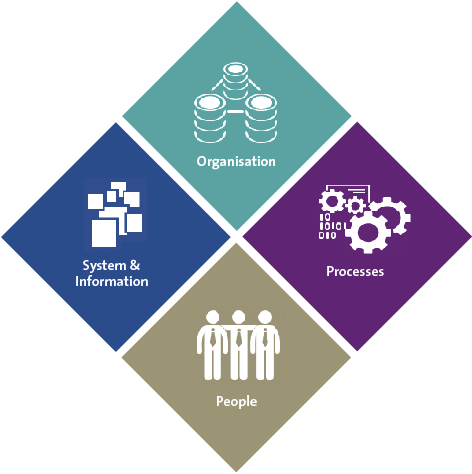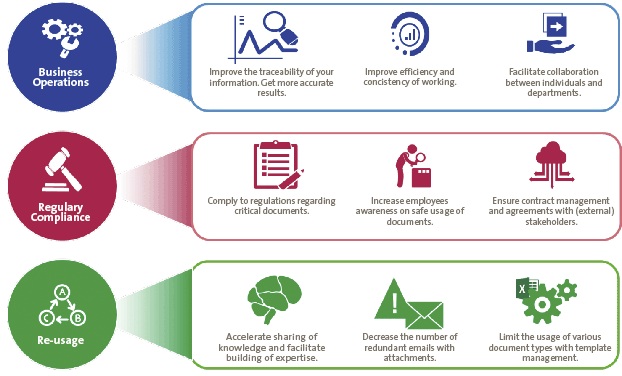The common way of working of an individual employee has radically transformed since the digitization of companies in the twenty-first century. Many versions of the same document are scattered throughout the company, or stored somewhere on a shared server, and communication goes directly through email, Skype, WhatsApp, and so on. All very flexible and fast, but the number of documents and communication has become so large that oversight is lost in most companies, raising serious compliance and operational issues. How to get a grip on documents and records? By making it personal!
Just another day at the office…
A critical deadline is quickly approaching. For months you and your closest colleagues have been working on a complex report for the board, but your efforts were fruitful and you seem to be ready on time. Then, disaster strikes. The input of one of the stakeholders who needs to approve the report appears not to be included in the final version and nobody seems to know in which version to search. Another question pops up: who has the latest version? Who is the owner of the final version? Where can I find the documents that contain the input of the stakeholder, but seem to be stored ‘somewhere on the share’? Did that colleague email it to me yesterday? If so, where are the attachments? Have we been working separately in the same document without knowing? Who is responsible for this mess? Can we still meet our deadline?
If you recognize yourself in the situation described above, do not be alarmed, you are not alone… Ever since the digitization of companies in the early twenty-first century, the common way of working of an individual employee has radically transformed. Every day, companies create, change, share and store millions of documents and emails. All aspects of the document life cycle, from creation to archiving, including the correspondence within and outside the company have fundamentally changed. We do not send letters anymore, but communicate directly by email, Skype, WhatsApp, and so on. We do not work in isolation on a product anymore, but send our earliest versions at any convenience to anyone we want to read it. We were used to expect a reply within a week; now some of us get annoyed when we have to wait more than an hour. We misuse our e-mail inbox intentionally as a back-up and search medium, because we are either too preoccupied or simply too lazy to manage our documents properly. And finally we used to keep our relevant documents close, now we store them without thinking on a shared server without using a good description most of the time, let alone making them ready for the purpose of archiving.
Challenges of our new era
It is obvious that this new way of working creates challenges. The number of documents and communication has become so large, even employees no longer have insight into what they have or have not received. Consequently, this leaves a feeling of work that is never finished, it causes frustration when documents are for example not immediately found, or despair when going through a flooded email inbox. Furthermore, knowledge and expertise is strongly fragmented among individual employees, because information is perceived as personal property. This creates a working environment in which it is unclear what the relevant information is, who the owner is and what the corporate strategy is to manage the information.
This leads to the unfortunate effect of an inefficient daily course of operations, a situation of incompliancy with laws and regulations and a high dependency on specific people. The same is illustrated in one of our client cases.
We ourselves are to blame for our current situation
It is a fact that not many companies have invested in Document and Records Management yet, let alone are on par with what is necessary to ensure good quality of information. What are the reasons behind the lack of attention for this domain? The answer is complex. One of the reasons that many companies are struggling to deal with this topic is that information has become something personal, instead of the property of a company. In essence, we consider document and records a personal asset without taking corporate ownership and responsibility. Back in the days when the number of documents was still manageable and communication was not as elusive as it is today, documents were perceived as an organizational asset. Today, many employees keep documents and information collected and created over the course of years to themselves, without feeling the need to share the company’s intellectual property. All knowledge about relevant documents is mostly concentrated at a small group of persons who use these documents primarily for the benefit of themselves and their direct colleagues. This situation could only arise because digitization was introduced gradually, and the responsible management could not judge appropriately what the impact would be on the information structure and way of working within the enterprise.
The case of a Dutch pension fund
A Dutch pension fund was facing similar issues as described earlier. In our assessment, it turned out that this company possessed almost one million files, some almost thirty years old. Documents critical to the organization or with a formal status were not always properly stored, nor were they traceable, archived or deleted. Examples were given in which employees were searching for a relevant document for more than three days, delaying other work and creating risks to the fund in legal cases.
The situation was created by the employees of the fund over the course of more than 20 years. It was certainly not done on purpose; Document and Records Management was simply not a point of attention. It created an environment for the individual employee to exercise their daily job without limits to document storage and archiving, leading to a large share containing many files in numerous versions without any form of naming convention. Not to mention the use of email and files stored locally. Email boxes were unlimited in size and therefore used as an easy way to chat with colleagues or exchange hundreds of versions of a file with many colleagues or as a poor substitute of an archiving application.
What was intriguing about the chaos that had emerged is that the direct effect on the daily business was not directly visible. The employees of the pension fund all developed their own way of working, knowing where to find documents in the latest version and accepting the loss of time in the use of several work-arounds. If information could not be found, one knew who to ask and another version was created and mailed. Still, all of the knowledge kept was concentrated at one or just a few employees. If these employees will leave the organization at some point in time, or when one of them forgets the location of relevant documents, then the full effect of this tolerated inefficiency will be become clear.
As a solution, we designed and implemented Document and Records Management at the pension fund, focusing on implementing a new more controlled individual way of working.
However, we ourselves are to blame. We blame our organization for not supporting us enough with ‘our’ information, while storing all relevant documents in our personal mailbox. We get irritated when we do not find the right document, but forget that we ourselves stored that document somewhere, somehow, without providing it with a proper description in the first place. We lose track of which version to use, but do nothing to manage earlier versions and finally we know policies on archiving and using templates exist, but decide to circumvent them where possible.
Figure 1. Value and necessity of Document and Records Management. [Click on the image for a larger image]
What is Document & Records Management?
Document Management is the (automated) coordination and control of the flow (storage, retrieval, processing, printing, routing, and distribution) of electronic and paper documents in a secure and efficient manner, to ensure that they are accessible to authorized personnel as and when required.
Some, but not all, documents within an organization become records. A record is a document with a formal status that needs to be made unchangeable for the sake of evidence and needs to be kept apart from other documents that are still necessary for the day-to day operations.
Records Management is focused on applying the required retention periods to stored items, identifying the owner of each records series, determining that a chain of custody and a proper audit trail both exist, assisting in e-discovery issues and applying legal holds to records when needed, managing the disposition (disposal of documents) and finally preserving records throughout their life cycle.[Derived partly from https://www.laserfiche.com/ecmblog/whats-the-difference-between-document-and-records-management for a concise definition. The proper standards for Document Management and Records Management are at this moment respectively ISO 10244 and ISO 15489.]
Does this mean that the situation of some decades ago was better in every way? Certainly not. Collaboration and the creation of documents is far easier these days. However, we used to have clear agreements on what documents and what records were important. We knew how long information needed to be stored or archived and when to discard the information. Finally, we had departments on a corporate level that supported us in managing information on an operational level. Setting the challenges aside, the digital era of today also brings numerous advantages compared to the past, such as easy collaboration, reuse of data, place and time-independent working and data accessibility wherever necessary.
To unlock the hidden value of documents and records in the digital era, we have to acknowledge our individual responsibilities more than we do now to rely on our own information and provide enough support from a corporate level for those documents and records that are important for the organization as a whole. But most importantly: make it personal!
Step 1: Make it personal
The first step is to make it personal. Consequently, the organization should start by creating awareness with the employee. Below are some examples of important statements regarding Document and Records Management:
- Realize that you are part of a process, so act accordingly. This includes knowing which tasks to fulfil, including the documents that should be created, shared, administered and handed over, but certainly also what the relation of those tasks is to other tasks in the process and those in related processes.
- Make a clear distinction between documents and records (archive) in your daily operations and handle them accordingly.
- Identify documents with a formal status or those that have a value for more than one department or business process and hand them over to those responsible in the organization when the document is in a final state.
- Understand the value of metadata and keep a list of relevant keywords you use to tag documents.
- Use predefined templates as much as possible, though keep challenging yourself and those responsible for the document in the application of the template.
- Keep only those versions of a document that are necessary for the completion of tasks; remove the rest.
- Agree upon ownership during the life cycle of a document upfront, before starting a process.
- Do not misuse your email box for archiving purposes and chat functionalities, but only use it for formal communication.
- Take notice of the agreed-upon naming conventions within your organization, or when absent, propose naming conventions.
Step 2: Enabling the organization
Parallel to creating awareness among employees, the organization should be enabled for proper Document and Records Management. The company should at first develop a framework for Document and Records Management; including a set of guiding principles, ownership of information, the desired end-state and a strategy to reach this new desired situation. Again, it is key to focus this framework both from the perspective of the company as from an individual perspective. The implementation of the frameworks asks for a tailor-made personal approach, requiring the employee to change his or her way of working, even though it may have been the same for the last 20+ years. We provide you with an example of such a framework in Figure 2.

Figure 2. KPMG’s framework for Document and Records Management.
The example framework (Figure 2) contains the following elements:
- Organization deals with information governance and other organizational aspects. This includes for example the definition of roles and their accountabilities, ownership structures and the commitment of stakeholders.
- Systems & Information covers aspects about IT infrastructure and the quality of documents, templates, metadata and records in terms of completeness, accuracy and reliability. Moreover, appropriate systems need to be available in order to deliver proper functionalities (e.g. template management/versioning/archiving).
- The pillar Processes is about the design and implementation of relevant processes, such as processes where data has been created, stored, maintained, transmitted, used, updated, handled, stored and destroyed, including their controls, KPIs and legal requirements.
- The pillar People deals with questions around the employee as an individual and organizational culture. For example, which interventions need to be taken in order to achieve that every employee will work in an integral and consistent manner with regard to Document and Records Management.
The second action is to provide the individual with the set of principles and show the gap between the current way of working and the desired way of working. Those include the elements as outlined in the framework. Thirdly, set up a small division dedicated to supporting information management, parallel to the already existing IT department. Thereafter, provide them with the proper tooling and automation of process steps where possible and finally, involve important key experts on certain documents and records in the implementation, to safeguard their knowledge and expertise for the organization as a whole.
For our client, we designed and implemented Document and Records Management according to the principles as outlined in this article; make it personal and enable the organization.
Dutch pension fund: personal approach to structure the company’s information
We designed and implemented Document and Records Management at the pension fund according to the displayed framework, focusing on the individual way of working. To achieve this, we started by defining principles together with the board, based on our assessment. These principles defined the guidelines for Document and Records Management within the pension fund, determining the roadmap to design and implement these and in the near future even the larger ambition of information management.
At first, a policy for document management and an archiving policy were drafted, as the basis for the newly designed governance organization for documents and records. This sets the boundaries for the redesigned processes. We reviewed the existing business processes such as contract management for the creation, editing, archiving and deletion of documents and introduced measures such as the settlement of ownership, the mandatory creation of metadata (e.g. keywords, owner, subject) and the use of pre-defined templates for common and important documents.
Most importantly, the employees had to be guided in changing their way of working. In this new way of working, the employee requires more extensive knowledge of its role in the process and the context in the organization, but also the documents and records that he or she handles. Contrary to earlier, the employee has to take into account metadata creation, the use of templates and compliance to legal requirements through for example archiving procedures. All this is facilitated by SharePoint, incorporating controlled document storage, archiving and governance through workflows. To achieve the change, we involved experts in the field of change management, to assist us in ‘delivering the message’.
Concluding
Unlocking the hidden value of Document and Records Management can be achieved by conducting two essential steps: make it personal and enable the organization. Properly taking into account these two aspects will create structure in the document and archive chaos that has emerged over the last decades and support business efficiency and compliance.





